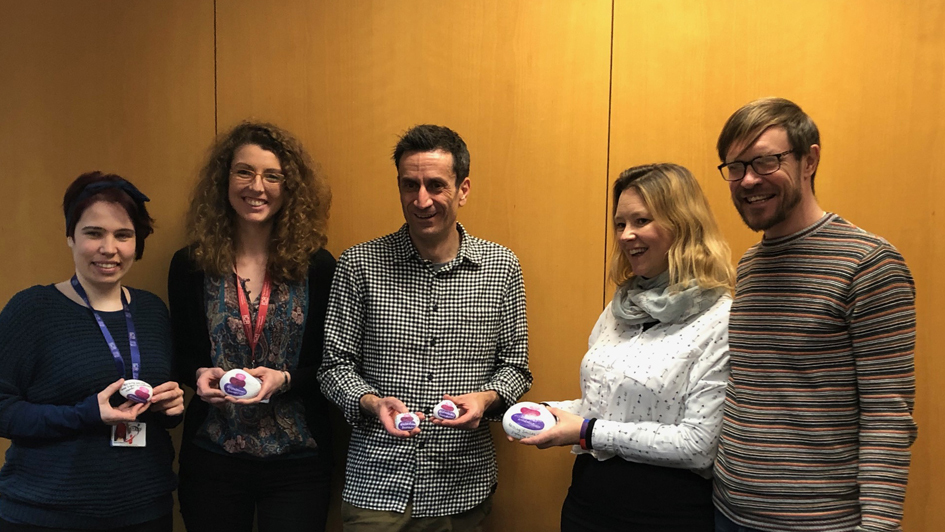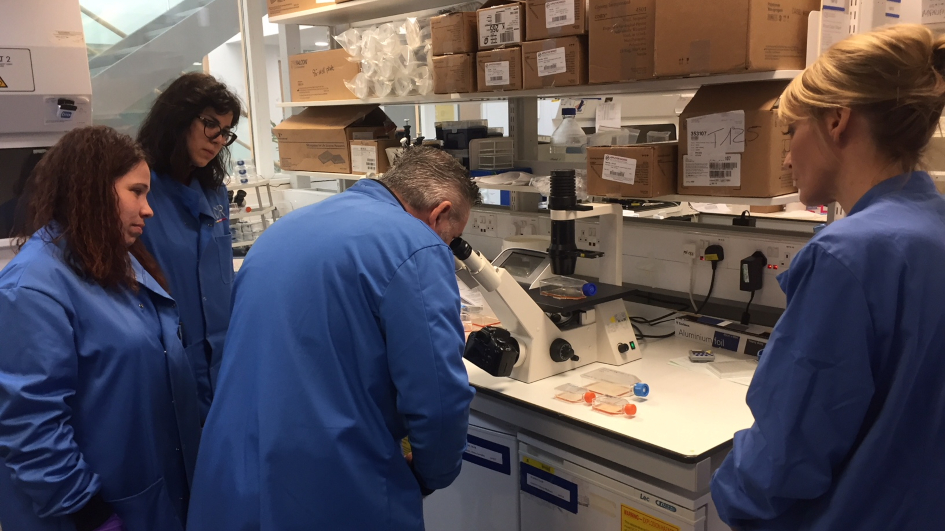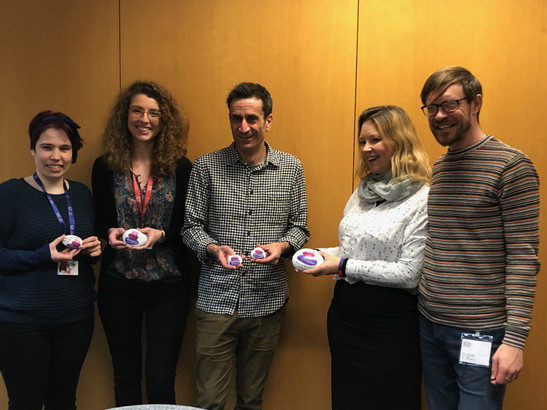
Image: Islastones Foundation visiting Professor Chris Jones' team. Left: Diana Carvalho
You are called to hospital. A child has been diagnosed with a brain tumour called Diffuse Intrinsic Pontine Glioma (DIPG). Surgery has started. You are there with your sample collection kit ready to go, waiting for the neurosurgeon to say, “Here is your tissue sample”.
Initially you’re excited – you are observing a leading neurosurgeon performing brain surgery. Then you remember it’s someone’s child on the operating table. Your heart sinks. Another child, another family.
It helps to stay focused on the why: analysing the brain tumour sample will give the family a diagnosis that will offer them the chance of targeted therapy for the child, and at the same time will help us better understand the complex biology of DIPG.
Surgery finishes and you are back in the lab.
Every child that has undergone a biopsy in the past 10 years has helped us better understand DIPG. If it wasn’t for them, we would still be in the dark about this disease. There are so many names, so many children. Their families are a driving force.
At the ICR we are lucky to work with family charity partners such as Abbie’s Army and the Islastones Foundation, who are dedicated to funding research into DIPG. In their pain, they found the drive to fight for a cause so that no other family has to go through it too. They are brave, they are courageous and totally unstoppable.
The ICR is an internationally leading research centre in the study of childhood cancers and cancers in children, teenagers and young adults.
Humbled by family visits
As a researcher working on DIPG, remembering the children and their families is what keeps me going, and doing the work. Science is exciting but these children and their family are our daily reminder of the real reasons we do our job.
Every time a family visits the lab we feel humbled. We show them cells under the microscope and different kinds of tests that are done in order to identify new drugs, and we talk about how excited we are about this new tissue sample that is growing in the flask.
When they look under the microscope and see the DIPG cells, they see the disease that has taken their child. That can’t be easy. They are facing the enemy. Instead of calling it all the names under the sun, they ask questions, they are interested, they are there to understand what DIPG is and what can be done about it.

Image: Ray and Amanda Mifsud of Abbie's Army look at DIPG cells under the microscope in the lab of Professor Chris Jones
New drugs targeting a genetic weakness in DIPG
DIPG is one of the most devastating childhood cancers. On average, children survive just nine to fifteen months. Radiotherapy is the standard of care and surgical removal of the cancer is not an option for these children as their tumour is located in an area of the brain that regulates vital functions such as breathing and swallowing.
Our understanding of DIPG dramatically changed in 2012-2014 when the first papers from our lab and others describing molecular changes in DIPG were published. Since then, the genomic landscape of DIPG has revealed a very complex and heterogeneous form of cancer, consisting of different subtypes that respond differently to treatment, and with mutations that make it unique from any other form of cancer.
In 2014, our Glioma Team, led by Professor Chris Jones, found that faults in the ACVR1 gene, not seen in any other cancer, could lead to DIPG. Since then, we have worked with open science company, M4K (Medicines for Kids) Pharma to develop brand-new drugs that block ACVR1. Last year, we found that this class of drugs could kill DIPG cells in the lab and shrink brain tumours in mice. We are expecting clinical trials in children with DIPG tumours to begin in the near future.
Open science companies aim to discover and develop affordable drugs for childhood diseases that are rare, where there is less market incentive and that aren’t well served by current business models.
The open science policy has allowed the DIPG research community to work together in a different way. It means science can move forward quickly and robustly, with experiments validated within the research community between different labs. More initiatives like this are needed too.
Combining and repurposing existing drugs
Very few cancers can be treated by a single drug, so prioritising the right molecular targets for drug combinations in DIPG is crucial. Although many molecular alterations are unique to DIPG, some are common to other cancers.
Repurposing existing targeted drugs that we know can cross the barrier between the bloodstream and the brain, and for which safety data is available, can be a quicker approach to bring new treatment options to the clinic.
Flexible clinical trial designs can help speed up the process too. One international DIPG clinical trial, BIOMEDE, led by colleagues at Great Ormond Street Hospital, uses an adaptive design involving drugs previously used in the treatment of other cancers.
This trial is expected to move into a next stage soon in the UK, and new treatment arms with novel therapeutic agents have been added. This flexibility allows new targeted therapies to enter clinical trials much more easily.
I’m proud of the steps we make every day to better understand DIPG and how we can treat it. The walk is measured and deliberate so that the next drug entering clinical trials has the best chance of working – and children with DIPG can a have a better chance at life.
How you can help support our work
We are a charity and rely on the support of partners, trusts and foundations, and individuals to fund our work.
If you would like to get involved and support our childhood cancer research contact Nicola Shaw in the Development Office: [email protected]
